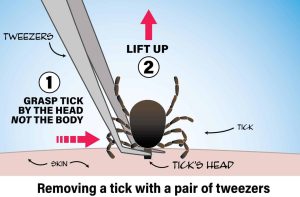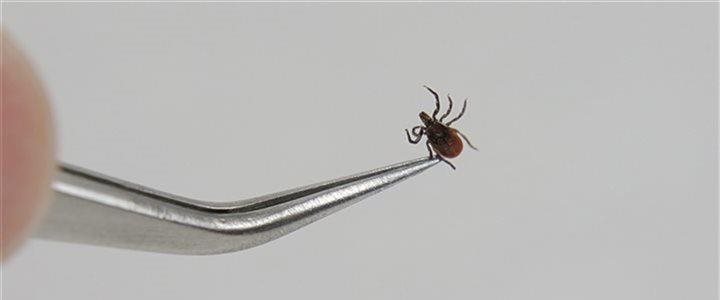If you think ticks are a concern only in the deep woods, it’s time to think again. Partially due to migrating deer populations, ticks are now abundant in suburban and city backyards – and they’re spreading disease. As a result, an estimated 476,000 Americans are infected with Lyme disease each year, according to estimates from the Centers for Disease Control and Prevention.
Tick exposure can occur year-round, but ticks are most active during warmer months (April-September). Know which ticks are most common in your area.
Before You Go Outdoors
- Know where to expect ticks. Ticks live in grassy, brushy, or wooded areas or even on animals. Spending time outside walking your dog, camping, gardening, or hunting could bring you close contact with ticks. Many people get ticks in their yards or neighborhoods.
- Treat clothing and gear with products containing 0.5% permethrin. Permethrin can treat boots, clothing, and camping gear and remain protective through several washings. Alternatively, you can buy permethrin-treated clothing and gear.
- Use Environmental Protection Agency (EPA)-registered insect repellents containing DEET, picaridin, IR3535, Oil of Lemon Eucalyptus (OLE), para-menthane-diol (PMD), or 2-undecanone. EPA’s helpful search tool can help you find the product that best suits your needs. Always follow product instructions. Do not use products containing OLE or PMD on children under 3 years old.
- Avoid Contact with Ticks
- Avoid wooded and brushy areas with high grass and leaf litter.
- Walk in the center of the trails.
After You Come In From Outdoors
Check your clothing for ticks. Ticks may be carried into the house on clothing. Any ticks that are found should be removed. Tumble dry clothes in a dryer on high heat for 10 minutes to kill ticks on dry clothing after you come indoors. Rather, if the clothes are damp, additional time may be needed. If the clothes require washing first, hot water is recommended. Cold and medium-temperature water will not kill ticks.
Examine gear and pets. Ticks can ride into the home on clothing and pets, then attach to a person later, so carefully examine pets, coats, and daypacks.
Shower soon after being outdoors. Showering within two hours of coming indoors has been shown to reduce your risk of getting Lyme disease and may effectively reduce the risk of other tickborne diseases. Showering may help wash off unattached ticks, which is a good opportunity to do a tick check.
Check your body for ticks after being outdoors. Conduct a full body check upon returning from potentially tick-infested areas, including your backyard. Use a hand-held or full-length mirror to view all parts of your body. Check these parts of your body and your child’s body for ticks:
- Under the arms
- In and around the ears
- Inside belly button
- Back of the knees
- In and around the hair
- Between the legs
- Around the waist
Preventing Ticks On Your Pets
Dogs are very susceptible to tick bites and tickborne diseases. Vaccines are unavailable for most tickborne diseases that dogs can get, and they don’t keep the dogs from bringing ticks into your home. For these reasons, using a tick-preventive product on your dog is essential. Tick bites on dogs may be hard to detect. Nevertheless, signs of tickborne disease may not appear for 7-21 days or longer after a tick bite, so watch your dog closely for changes in behavior or appetite if you suspect your pet has been bitten.
Talk to your veterinarian about:
- The best tick prevention products for your dog
- Tickborne diseases in your area
Meanwhile, to further reduce the chances that a tick bite will make your dog sick:
- Check your pets for ticks daily, especially after they spend time outdoors.
- If you find a tick on your pet, remove it right away.
- Reduce tick habitat in your yard.
Note: Cats are extremely sensitive to a variety of chemicals. Do not apply tick-prevention products to your cats without first asking your veterinarian!
Note–September 21, 2018: FDA Fact Sheet for Pet Owners and Veterinarians about Potential Adverse Events Associated with Isoxazoline Flea and Tick Products. For additional information, please talk to your veterinarian.
Apply Pesticides Outdoors to Control Ticks
The use of pesticides can reduce the number of ticks in treated areas of your yard. However, you should not rely on spraying to reduce your risk of infection.
When using pesticides, always follow label instructions. Before spraying, check with local health or agricultural officials about:
- The best time to apply pesticides in your area
- The best type of pesticide to use
- Rules and regulations regarding pesticide application on residential properties
Create a Tick-safe Zone to Reduce Blacklegged Ticks in the Yard
The Connecticut Agricultural Experiment Station has developed a comprehensive Tick Management Handbook pdf icon[PDF – 84 pages]external icon for preventing tick bites. Here are some simple landscaping techniques that can help reduce black-legged tick populations:
- Remove leaf litter.
- Clear tall grasses and brush around homes and at the edge of lawns.
- Place a 3-ft wide barrier of wood chips or gravel between lawns and wooded areas to restrict tick migration into recreational areas.
- Mow the lawn frequently.
- Stack wood neatly and in a dry area (discourages rodents).
- Keep playground equipment, decks, and patios away from yard edges and trees.
- Furthermore, constructing fences prevents unwelcome animals (such as deer, raccoons, and stray dogs) from entering your yard.
- Remove old furniture, mattresses, or trash from the yard that may give ticks a hiding place.
If you find a tick attached to your skin, remove the tick as soon as possible. Several tick removal devices are on the market, but a plain set of fine-tipped tweezers works well.
How to remove a tick
- Use clean, fine-tipped tweezers to grasp the tick as close to the skin’s surface as possible.
- Pull upward with steady, even pressure. Don’t twist or jerk the tick; this can cause the mouth parts to break off and remain in the skin. However, if this happens, remove the mouth parts with tweezers. Otherwise, if you cannot remove the mouth easily with tweezers, leave it alone and let the skin heal.
- After removing the tick, thoroughly clean the bite area and your hands with rubbing alcohol, soap, and water.
- Never crush a tick with your fingers. Dispose of a live tick by
- Putting it in alcohol,
- Placing it in a sealed bag/container,
- Wrapping it tightly in tape, or flush it down the toilet.

If symptoms occur, please consult with a provider to check for tickborne illnesses
Many tickborne diseases can have similar signs and symptoms. Additionally, if you get a tick bite and develop the symptoms below within a few weeks, see your healthcare provider. The most common symptoms of tick-related illnesses include:
Reviewed by Tomah Health Infection Prevention Team: 12/17/2024

